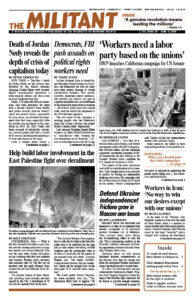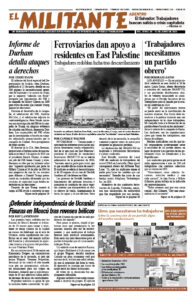As prices continue to rise, especially on necessities like food, housing and health care, and as the worldwide decline in capitalist production and trade threatens layoffs, insistence by Joseph Biden administration officials that the economy is doing well ring hollow.
Over a third of households were worse off financially in 2022 than a year earlier, reports a May 22 Federal Reserve survey. Some 18% of workers said that higher prices force them to work more hours or add on another job. And 37% said they wouldn’t be able to cover a $400 unexpected expense like a car breakdown or medical emergency.
At the same time, the Fed has been jacking up interest rates monthly, adding rising rates on credit cards and other debts workers are saddled with.
The economic crisis facing working people in Europe is just as bad, and in some countries even worse. In the U.K. food prices in April were 19.3% higher than a year ago. In France households have cut their food purchases by more than 10% since Moscow’s invasion of Ukraine.
The German economy, the largest in Europe, is now officially in a recession, with declining industrial production and falling retail sales. In Spain working people face an unemployment rate of 13.3%.
Today’s double whammy hitting working people points to a strong likelihood of an extended period of stagflation, where rising prices are combined with stagnating capitalist production and hiring, both in the U.S. and worldwide.
This comes as the bosses’ response to rough conditions and increased competition is to take it out on their workers, pushing to cut workers and jack up the line speed, reduce wages, increase hours, impose divisive two-tier wage schemes and other attacks.
With the administration’s pronouncement that the COVID-19 pandemic is over, hundreds of thousands of lower-income workers have been cut off from Medicaid.
Earlier this year, 93 million people — over 25% of the U.S. population — were enrolled in Medicaid or the Children’s Health Insurance Program, up from 71 million before the pandemic. Budget cuts projected by the federal government would eliminate another 15 million people from coverage.
Debra Miller, of Bullhead City, Arizona, lost Medicaid coverage in April because officials said her $25,000 annual wage at Burger King made her ineligible. A single mother with diabetes and hypothyroidism, she was told she had to buy her own insurance now through Obamacare at a $70 monthly premium.
“You have a car, mortgage, kids, food,” she told the New York Times. “You really don’t have that much left to pay that much for health insurance.”
At the same time, government officials have made it increasingly difficult for workers injured on the job to get Social Security disability benefits. Over the past couple of years federal judges hearing appeals ruled against denying benefits in 60% of the cases they heard. These cases were sent back to be reviewed. But the burden of a drawn-out fight to get the benefits lies on the back of the workers.
“They’ve done everything to prolong this to get me to quit,” Michael Sheldon told the Washington Post. He was hurled off a road-paving machine in 2006 and has been fighting for benefits since.
High rents and mortgage rates have made it difficult for young workers in particular to be able to afford getting their own place to live and raise a family. Many are forced to move in with their parents, other relatives or friends.
The birth rate has plummeted from 24 per 1,000 people in 1950 to about 11 today. Looked at another way, if fertility rates had stayed even at their 2007 level, there would be 9.6 million more children alive in the U.S. today.
“Young Americans Are Dying at Alarming Rates,” headlined a May 17 Wall Street Journal article. It’s now at its highest level in nearly 15 years, from drug overdoses, suicides, homicides and car crashes.
Despite significant gains in medical care, life expectancy in the U.S. has fallen to 76 years today, its lowest level in over a quarter century.

